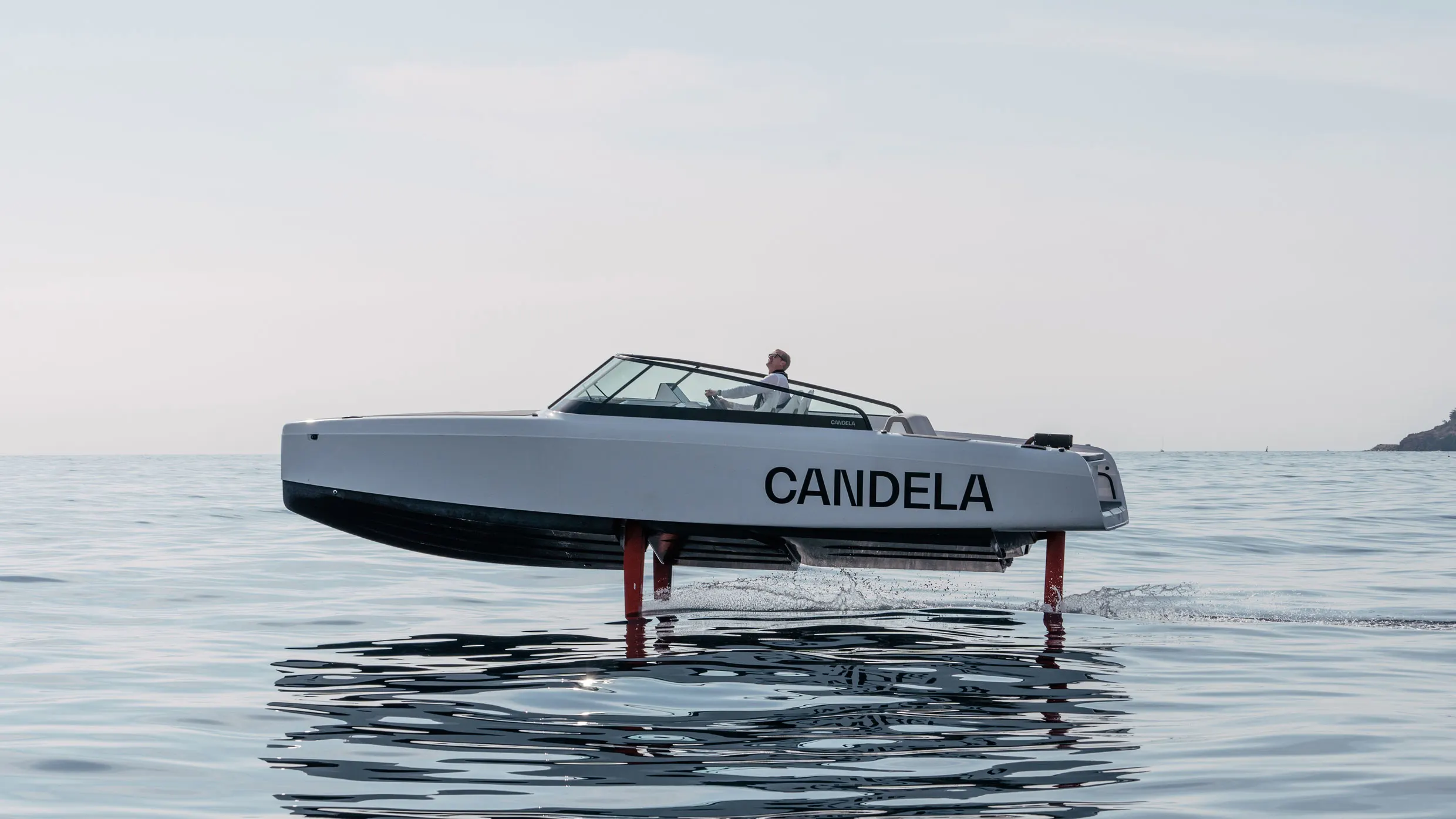Racing along the Potomac River at 26 knots (almost 30 mph) usually guarantees a raucous ride—but not on a battery-electric Candela C-8 hydrofoil.
Instead of the roar of a conventional boat’s fossil-fueled engine and the smack of its hull on the water, this vessel smoothly whirled along, barely shuddering over the wake of a passing water taxi as its foils cleanly sliced through the surface.
The placid experience belied the speed shown on the C-8’s touchscreen. And the loudest noise heard on a mid-October ride came not from the C-8’s electric motor, but from planes taking off from Washington National Airport that were following a prescribed course above the river.
Stockholm-based Candela (a Most Innovative Companies honoree in 2025) doesn’t just want to electrify the boating-for-fun experience, however. Along with a few other companies, it aims to purge fossil fuels from the passenger ferries that regularly ply city waterways.
A ride for the ruling class
You can think of the C-8, starting at $300,000, as a Candela equivalent of the Tesla Roadster—the high-priced plaything that helps boot up a line of more useful electrified conveyances.
The hardtop edition we took around the Potomac and the Anacostia rivers is a sleek machine that drew compliments from boardwalk passersby when we pulled up to the Washington Harbor development in Georgetown.
The C-8 pulls out of a marina as a boat, but then starts flying on its foils at about 17 knots (19.5 mph). Candela’s engineers are fixated on foils—not only because of the speed they allow but also because, by getting the hull above the water, they vastly cut down on the drag.
Candela quotes a range of 57 nautical miles (almost 66 miles) for the C-8’s 69 kWh battery, with the ability to go from 10% of a charge to 80% in under 30 minutes with 135 kW DC charging.
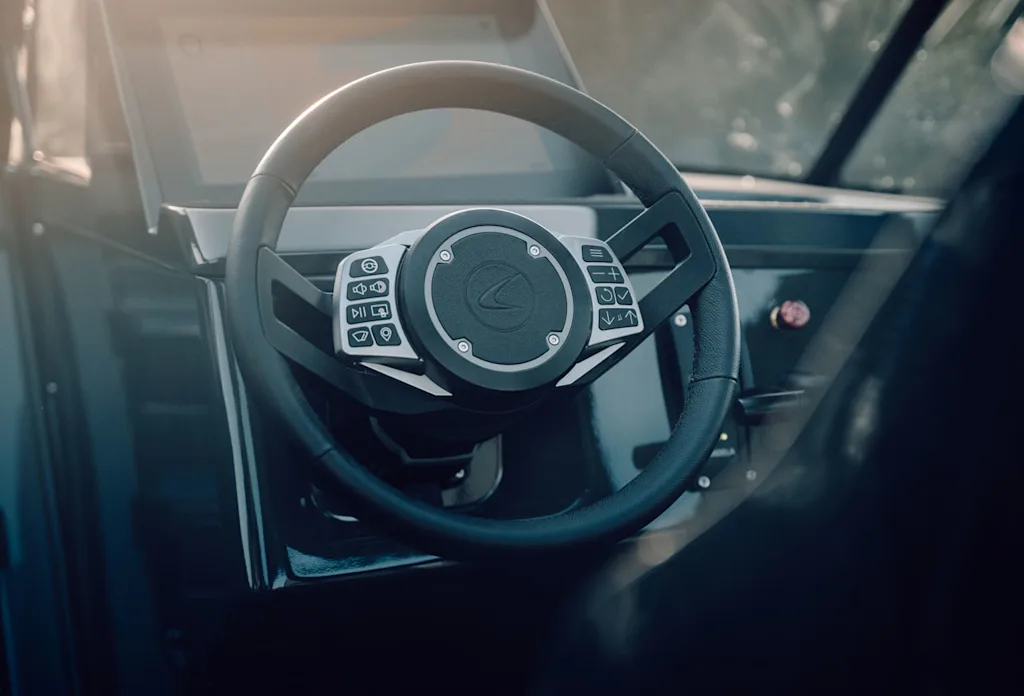
You helm the C-8 via a steering wheel, a throttle, and a 15.4-inch touchscreen. Candela’s software monitors the boat and will automatically slow it down if you bank it too much—as I found out firsthand during an August 2023 ride on the San Francisco Bay in an earlier model of the C-8.
Three seats and a bench aft of them can accommodate up to six passengers, while a cozy belowdecks space forward of the controls hides sleeping quarters and, below a cover, a small toilet.
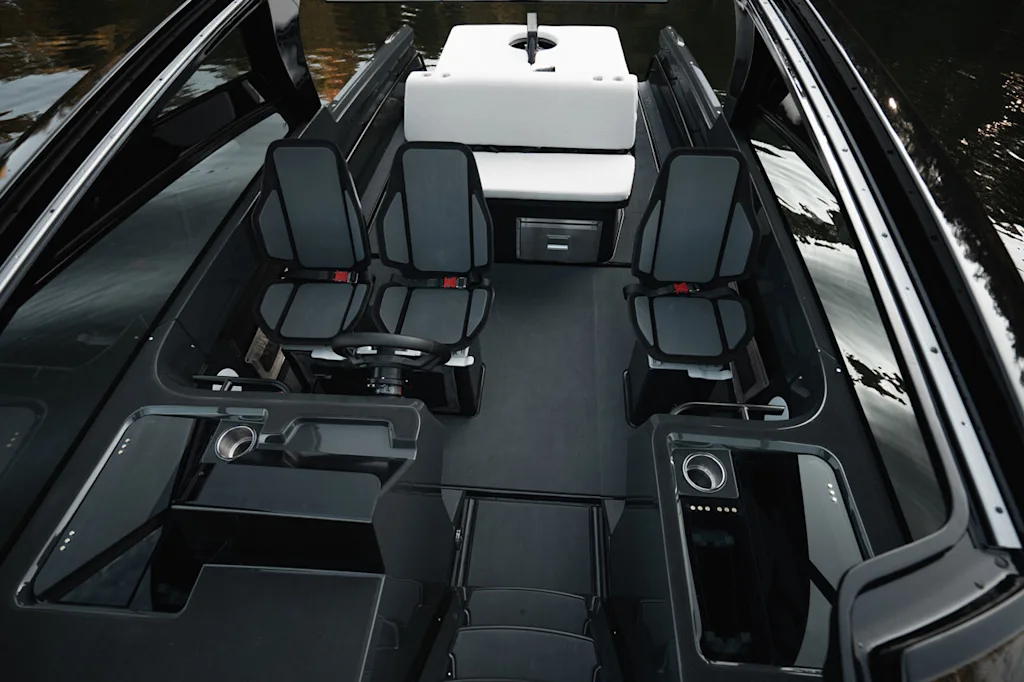
Almost two hours of cruising up and down the Potomac and the Anacostia, most of it on the foils, took the battery from 100% of a charge to 63%.
Candela has sold more than 100 C-8s and delivered about 90, spokesperson Mikael Mahlberg says; about half of those deliveries have gone to US customers. It has also delivered 32 C-7 boats, the company’s debut electric hydrofoil that it no longer produces.
The privately held firm has raised $96.2 million in funding so far, according to Crunchbase data, but isn’t disclosing financial details. “We’re aiming to be profitable next year,” Mahlberg says, describing Candela’s current phase as “a hyper-growth curve” optimized for research, development, and sales.
Fossil-fuel-free ferries
That joyride on the C-8 doubled as a chance to show off how passenger ferries can provide a useful transportation alternative.
With Washington roads gridlocked due to Ukrainian President Volodymyr Zelenskyy’s White House meeting with President Trump, as well as the annual meetings of the International Monetary Fund and the World Bank Group, my boating-enthusiast friend Bob Vanasse couldn’t make it to Columbia Island Marina on the south side of the Potomac. So we zipped up to Washington Harbor to pick him up there instead.
Vanasse, whose day job is representing seafood and fishing-industry interests, pronounced himself impressed and gave an impromptu sales pitch to a guy at his boat club by the District Wharf in Southwest DC, when we pulled up there.
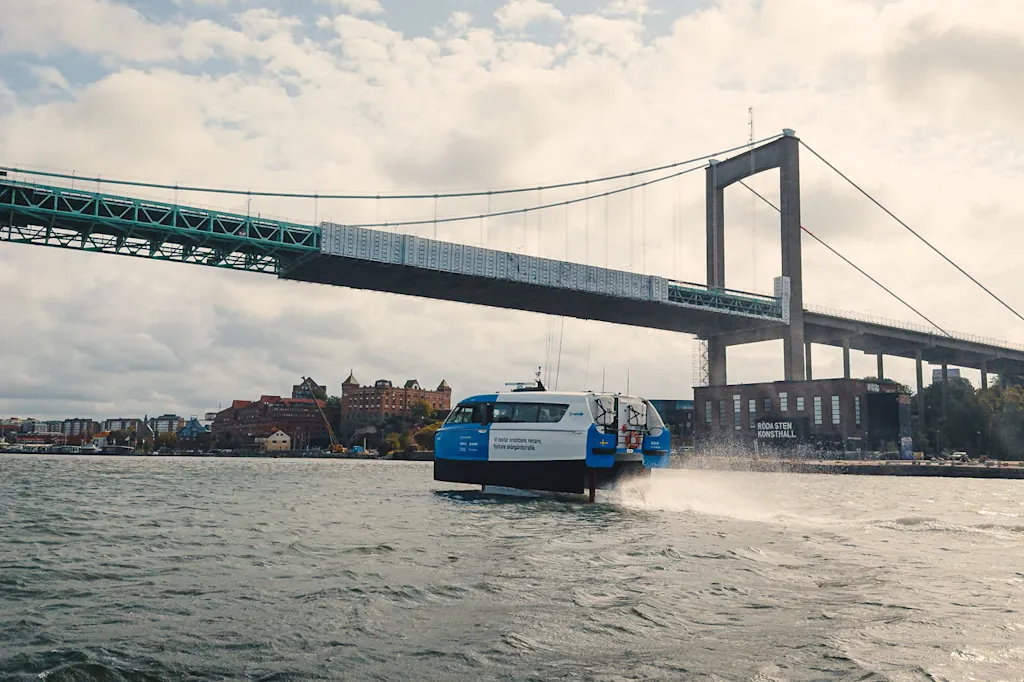
Candela aims to offer that convenience to larger groups of people with its P-12 battery-electric hydrofoil ferry. It can transport up to 30 people at a cruising speed of 25 knots (almost 29 mph), with a range estimated at 40 nautical miles (46 miles).
Candela doesn’t specify a price for the ferry; Mahlberg only says it’s “of course more expensive” than the C-8 and “slightly more expensive to purchase than the cheapest diesel vessels of the same size”—offset by annual operating costs about 60% to 70% lower.
As with electric vehicles, the low maintenance of an electric motor makes a large contribution to those savings.
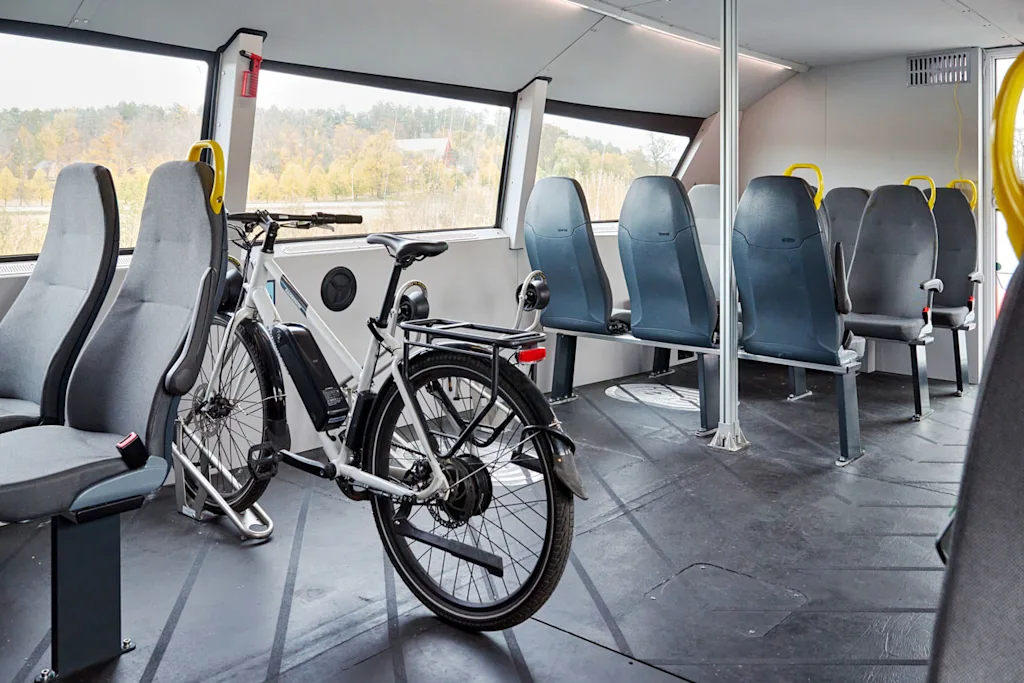
The P-12, however, is just pulling out of the dock in terms of commercial deployment. One P-12 is providing ferry service around Stockholm—where Candela was able to get a waiver from no-wake speed limits, cutting travel time on an 11-mile commuter route from an hour to 30 minutes—and another serves as a demo vessel for the firm.
Candela has 50 P-12 orders booked, with plans to deliver the first eight starting in the first quarter to customers in Saudi Arabia and Mumbai. And it has one new US ferry operator, FlyTahoe, that’s considering the P-12 for a planned service going north and south across Lake Tahoe.
FlyTahoe CEO Ryan Meinzer says that the company, based in San Francisco and Tahoe Vista, California, considered and rejected non-hydrofoil ferry concepts.

“Conventional hull and propulsion designs—even when electric—still displace water as they push through it, making them far less efficient and less comfortable in choppy conditions,” he says.
Meinzer isn’t disclosing FlyTahoe’s financial arrangements with Candela but says the company is “advancing toward a tentative 2026 launch for our cross-lake service, subject to regulatory approval.”
Candela, meanwhile, will need to start building boats in the US to advance its own ferry business here—pre-Depression US laws impose a buy-American requirement on vessels transporting people between American ports.
“The US is potentially our biggest market potential,” Candela’s Mahlberg says. “We’re in advanced discussions with several states regarding a US factory, and we hope we can shed more light on this soon, as we aim to deliver our first US vessel in 2026.”
Other passenger ferry prospects
Candela already has company in that market. Belfast-based boat builder Artemis Technologies inked an agreement in February with the US firm Delta Marine to develop battery-electric hydrofoils for Puget Sound routes. Artemis’s EF-24 will carry 150 people at a cruising speed of 34 knots (39 mph) and a range on foils of 70 nautical miles (80.5 miles).
And in the Bay Area, the San Francisco Bay Ferry placed an order in December for three battery-electric, 150-passenger catamaran ferries from All American Marine, with the first vessel set to begin service on its shorter routes in early 2027. That ferry operator’s electrification ambitions include converting four 400-passenger diesel ferries to electric power.
Putting batteries in a boat might seem like a much more ambitious venture into zero-emission transportation than electric cars, but the concept also has some nonobvious virtues.
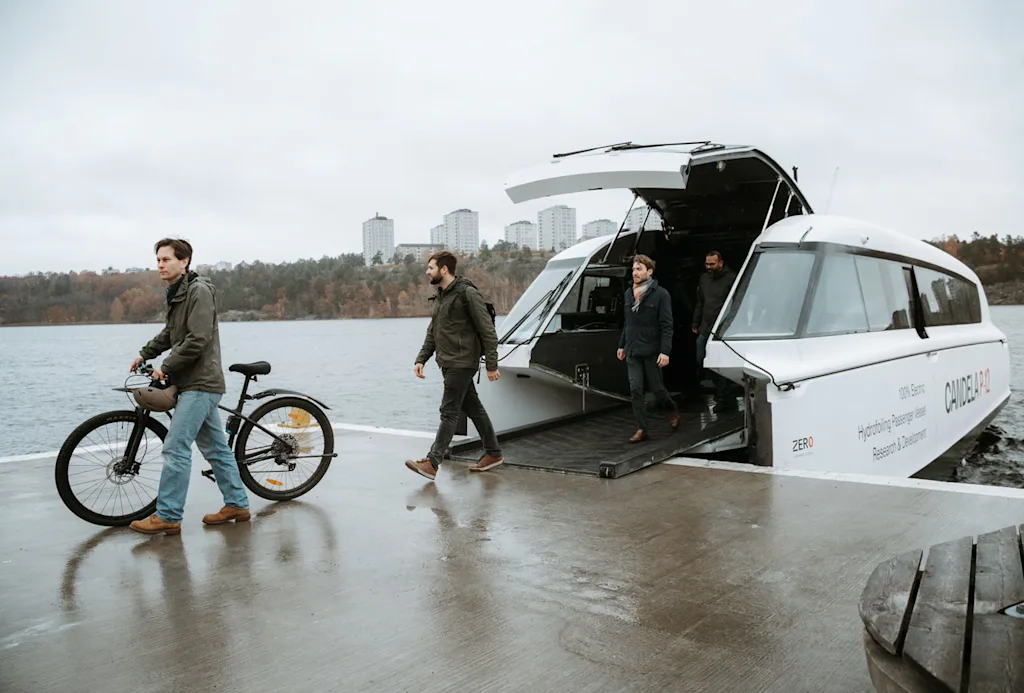
“Ferries are the largest vessels capable of becoming pure electric due to their well-defined operational profiles—often the exact routes, energy profile, stoppage times, size, load requirements, etc., are accurately known during the powertrain design, eliminating range anxiety and allowing high-cost batteries or other energy storage systems to be right-sized,” says Mika Takahashi, senior technology analyst at IDTechEx, a Cambridge, England-based research firm.
But electric ferries also constitute a tiny fraction of the worldwide ferry fleet. IDTechEx estimates that only 280 e-ferries have been sold, with 440 more sales predicted through 2030. In the US alone, 604 passenger ferries were in service in 2022, per the latest Department of Transportation statistics available; the industry group Interferry estimated there were 15,400 in operation worldwide in 2019.
Takahashi also notes two other possible obstacles. One is “being a relatively small subset of the EV industry” relative to cars, meaning a slower pace of innovation. Another is “unpredictable policy shifts” in the US and other countries—such as the Trump administration’s weird and evidence-detached hostility to EVs.
The early-rate deadline for Fast Company’s World Changing Ideas Awards is Friday, November 14, at 11:59 pm PT. Apply today.

